 A number of different kinds of switches are available to help you keep track of whether or not your door is shut and / or locked. Here are some of them:
A number of different kinds of switches are available to help you keep track of whether or not your door is shut and / or locked. Here are some of them:
Door Status Monitor Switch
A door status monitor switch changes states when the door is opened or closed. Typically this is accomplished by using a magnetic reed switch, either surface mounted or concealed in the edge of the door and door frame like the one shown at right.
How a Magnetic Reed Switch Works
The magnetic reed switch is typically installed on the door frame and the magnet that activates the switch is typically installed on the door. Inside the magnetic reed switch, a thin piece of steel – a steel ‘reed’, if you will – is held in position by the attraction of the magnet when the door is closed. When the door is opened, the magnet is taken away from the switch and the spring tension of the “reed” causes it to spring back against the other contact, changing the state of the switch.
Most magnetic reed switches are normally closed – “closed loop” – but are also available normally open (“open loop”) SPDT (single pole double throw, or “form C”) or DPDT (double pole double throw).
The Purpose of the Door Status Monitor Switch
The door status monitor switch is used to notify remote devices that a door is open or closed. Typically these remote devices are burglar alarm panels or access control system controllers. It does not tell you if the door is locked, just if it is closed.
Request to Exit Switch
The request to exit switch, also known as a REX switch, is so named because it is usually connected to the request to exit contacts on an alarm panel or access control board. It is used to notify an external device that someone is exiting through, or wants to exit through, a door. REX switches come in a wide variety of configurations, from push button palm switches engraved “push to exit” to switches concealed inside exit devices. A motion exit sensor is also a form of request to exit switch.
Request to exit switches are available with a wide variety of contact configurations and with or without electronic or pneumatic time delay. If the switch is being used as a means of egress for pedestrian traffic, it will need to comply with life safety code. Life safety code varies from locality to locality as governed by your local AHJ – Authority Having Jurisdiction – that is, your local building inspector or fire marshal.
Latch Bolt Monitor Switch / Strike Monitor Switch
I write about Latch Bolt Monitor (LBM) switches and Strike Monitor Switches because they somewhat overlap. Both are designed to monitor the position of the latch bolt.
overlap. Both are designed to monitor the position of the latch bolt.
Some LBM switches are inside locks and others are in electric strikes. From inside the lock, they monitor whether the latch is extended or depressed. When located in an electric strike, they monitor whether or not there is a latch bolt present in the keeper.
Pictured at right is Securitron’s line of inexpensive strike monitor switches as examples of strike monitor switches. Several companies offer like products. Strike monitor switches are an easy way to monitor if there is a latchbolt (or some other object) present in the keeper. Several companies, such as Von Duprin, offer heavier duty monitor strikes. Monitor strikes are sold as a finished unit that includes as strike and a switch whereas strike monitor switches are aftermarket add-on units.
Magnetic Bond Sensor / Bond Sensor
Magnetic bond sensor and bond sensor options refer to electromagnetic lock applications. Many manufacturers offer Bond Sensor or Magnetic Bond Sensor as an option. What this does is allow an electromagnetic lock to notify some external device that its holding force is below spec. Authorities are alerted and the situation is addressed.
Maximizing Effectiveness
To maximize effectiveness of door monitor switches, it is best to use both a door status monitor and some kind of lock status monitor as well, and this is why: because monitor switches can be fooled. A door status switch will tell you if the door is open or closed – unless it has been altered to tell you the door is closed when it is not. Also, a door may be closed, but not locked. If you have a latch bolt monitor or magnetic bond sensor in place as well as a door status switch, you will know if the door is closed but not locked.
This is the center of this knowledge: to know that the door is shut AND locked.
